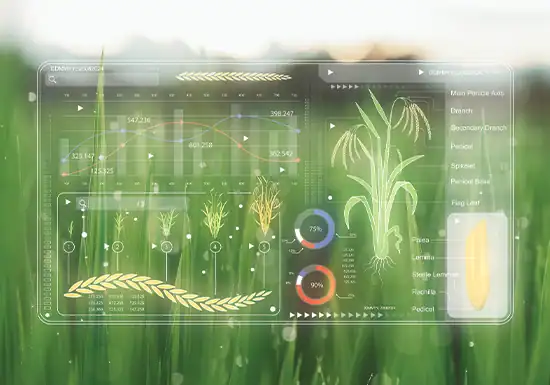Agroecology Modelling: How Computer Science Is Transforming Sustainable Farming
Updated: June 26, 2025

How can we feed 10 billion people by 2050 without exhausting the planet that feeds us? With climate change accelerating, biodiversity declining, and arable land shrinking, this question is no longer theoretical. Instead, it has become one of the defining challenges of our time. Traditional agricultural methods, while productive, often degrade ecosystems over time. In contrast, agroecology — an approach that merges farming with ecological principles — offers a sustainable path forward.
Yet despite its promise, agroecology is inherently complex. It relies on dynamic systems that mimic natural ecosystems, using crop diversity, composting, and biological pest control to improve sustainability and resilience. But these ecological interactions are unpredictable and nonlinear, making it difficult to scale solutions effectively. That’s where computer science steps in. Through agroecology modelling, we now have the tools to simulate, optimize, and adapt ecological farming practices in ways never before possible.
Agroecological systems involve countless interacting variables: soil quality, rainfall patterns, insect populations, planting cycles, and more. Understanding how they influence one another is essential. Agroecology modelling uses mathematical frameworks and computer simulations to map these interconnections. These models allow researchers and farmers to anticipate outcomes, test strategies virtually, and make more informed decisions in real time. Instead of waiting for an entire growing season to see what works, simulations can model years’ worth of environmental interaction in minutes.
The Technology Behind Agroecological Models
Agroecological models range from traditional simulation software like DSSAT (Decision Support System for Agrotechnology Transfer) and APSIM (Agricultural Production Systems Simulator) to modern AI-powered platforms that integrate machine learning and big data analytics. These tools ingest data from a wide range of sources — satellites, drones, soil sensors, and weather stations — to construct increasingly accurate models of ecosystems.
Some models are agent-based, meaning they simulate the behavior of individual elements, like plants, insects, or farmers, to see how local interactions shape system-wide outcomes. Others use GIS (Geographic Information Systems) to map terrain and assess how variables like elevation or water flow affect crop health.
Computer science techniques such as neural networks, optimization algorithms, and statistical learning are now foundational to many of these systems. By marrying these tools with ecological science, we’re gaining a level of precision and foresight that traditional farming methods alone cannot offer.
It may seem like a leap from Python scripts to planting seeds, but agroecology modelling relies heavily on computer science expertise. Agricultural researchers need programmers who can code robust models, data scientists who can extract patterns from climate and soil data, and AI specialists who can build systems that learn over time.
A great example lies in predictive analytics for pest control. Instead of blanket spraying pesticides, AI models can forecast pest outbreaks based on weather data and prior infestations, helping farmers act proactively and sustainably.
Computer science isn’t just enabling precision — it’s enabling access. Mobile-based tools powered by cloud computing now bring agroecological insights to farmers in remote regions, democratizing knowledge that once sat in scientific papers or university labs.
Data-Driven Farming for a Sustainable Future
Across Africa, Asia, and Latin America, NGOs and international organizations are adopting agroecological models to support smallholder farmers facing climate disruption. In the global North, these models are being used to reimagine food systems that are not only productive but regenerative.
Of course, we must tread carefully. Ecological systems are deeply local, and models that ignore traditional knowledge risk flattening diversity in the name of scalability. Ethical modelling includes participatory design, where farmers and scientists co-create solutions.
The future of agroecology will be a hybrid, including part satellite, part soil, part AI, part ancestral wisdom. And that hybrid future needs translators: people fluent in both digital code and ecological context.
At the University of the People, we see computer science as a discipline offering far-reaching opportunities to solve the planet’s most pressing challenges. Our online Bachelor’s Degree in Computer Science equips students with foundational knowledge in algorithms, data management, AI, and machine learning — all tools that are increasingly applied in domains like climate resilience and sustainable agriculture.
Our global, tuition-free model is uniquely positioned to serve students from farming communities and urban centers alike, allowing learners to apply their knowledge locally while engaging with global issues. Whether you’re interested in building the next agroecology simulator or contributing to open-source sustainability tools, UoPeople prepares you not just for the tech industry but for leadership in the digital era.
Agroecology modelling represents a compelling fusion of ecological wisdom and computational innovation. It’s a field that asks big questions about how we live, grow, and sustain life on Earth, and answers them with algorithms, sensors, and code.
For students and professionals in computer science, this is a call to action. Your skills can shape a healthier, more equitable food system. And for anyone wondering whether a computer science degree can lead to meaningful, world-changing work, the answer is growing, quite literally, in the fields.

